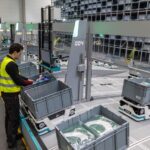Uber concluded 2024 on a high note, smashing records across key metrics and is now leaning heavily into its vision for autonomous vehicles (AVs).
Speaking ahead of Uber’s Q4 earnings call, CEO Dara Khosrowshahi detailed the company’s achievements and outlined ambitious goals to fortify Uber’s position atop the ridesharing sector amid the AV revolution.
“We exited 2024 with balanced growth across Mobility and Delivery, leaving us very well positioned for 2025,” Khosrowshahi announced.
With constant-currency year-over-year (YoY) growth in Gross Bookings of 21% – reaching $44.2 billion in the quarter – Uber exceeded internal expectations. Yet, beyond the numbers, what stole the spotlight was the company’s commitment to autonomous driving technology.
Uber eyes $1 trillion autonomous vehicles opportunity
“2024 was a turning point for the [AV] industry,” Khosrowshahi declared.
With firms like Waymo, WeRide, and Baidu delivering fully autonomous rides in limited geofenced areas, and others – including Tesla and Zoox – advancing rapidly, Khosrowshahi noted the sector’s “magic” moment as more consumers experience driverless trips.
However, Uber’s narrative doesn’t cast AVs merely as a disruptor to its existing human-driven model; instead, they are positioned as a transformative opportunity.
“Uber is uniquely positioned to capture the $1 trillion+ opportunity that autonomy will unlock in the US alone,” Khosrowshahi said.
Khosrowshahi’s bold assertion stems from Uber’s decade-plus dominance in dynamic fleet management, its vast customer base, and operational expertise. From ride variability to on-demand logistics, Uber’s finely tuned platform could grant it a competitive edge in a world transitioning to autonomous vehicles.
Five hurdles to surmount
Khosrowshahi unpacked five critical hurdles that AV technology must surmount to achieve large-scale commercialisation and showcased Uber’s readiness to address each:
- Safety standards: Khosrowshahi stressed the importance of “an extremely high safety standard” for public trust in AVs. Uber applauded Waymo’s meticulous transparent safety practices and called for industry-wide vigilance. “It is our view that AVs will need to be orders of magnitude safer than human drivers in order to earn the trust of the public,” he asserted.
- Regulatory challenges: Fragmented policies across states and countries present significant bottlenecks. “In the US, we welcome a more standardised national framework,” Khosrowshahi said. With international regulatory frameworks still evolving, Uber made inroads with a global launch of AVs in Abu Dhabi and plans to expand further in 2025.
- Cost-efficiency and scalability: Automated vehicles remain prohibitively expensive, with retrofitted models costing upwards of $200,000 per car. OEM capacity is lagging, Khosrowshahi explained, but progress here will be vital. “We believe that in the long run, autonomy will be an enabling technology, and all new vehicles will be sold with L4-capable software,” he expressed hope for a future where manufacturers produce AVs at scale for mainstream adoption.
- Operational expertise: “An average-utilised AV can run as much as 100,000 miles a year, compared to a typical consumer vehicle running just 10-15,000,” Khosrowshahi shared. This intensity necessitates frequent charging, cleaning, and servicing—tasks Uber is seasoned at managing with its partnerships, fleets, and operational capabilities already honed through years of ridesharing dominance.
- Demand variability: Ridesharing demand is inherently unpredictable, with sharp peaks and valleys dependent on time, day, and year. This presents a paradox for any standalone AV network: a fleet sized for peak demand would sit idle for much of the day; conversely, a smaller fleet would be stretched too thin during busy periods. On this front, human drivers continue to be invaluable for flexibility. “Given the scale of the Uber platform, and human drivers’ ability to dynamically fulfil demand spikes… a hybrid of AV and human drivers will deliver the highest asset utilisation,” Khosrowshahi explained.
Uber fosters collaborations in autonomous vehicles
Uber has been diligent in fostering partnerships with the leading lights of self-driving technology while simultaneously establishing its own foothold.
Notable collaborations include Waymo, with the company set for public AV launches in Austin (next month) and Atlanta (this summer). Beginning this week, Austin residents can join Uber’s “Interest List” via the app to be among the first matched with Waymo’s autonomous vehicles once the service launches.
International expansion also remains on the cards. Khosrowshahi hinted at multiple launches, following Uber’s inaugural AV deployment in Abu Dhabi. Regions with supportive AV policies and progressive regulatory environments are under consideration for closer collaboration between Uber and AV developers.
Khosrowshahi foresees a future wherein Uber’s network seamlessly blends human-driven and autonomous rides. Rather than AVs entirely displacing traditional drivers, the two would work in unison to address the nuances of demand. With Uber’s scale, this hybrid approach could unify the low-cost efficiency of AVs with the adaptive flexibility of human drivers.
If it succeeds as planned, Uber might emerge as the first major player to deliver mass-market deployment of AVs without compromising consumer expectations like reliability and pricing.
Clearly, Uber views autonomous vehicles as central to its future. Khosrowshahi’s call to action leaves no doubt about this: “We are spending an enormous, yet appropriate, amount of organisational energy to execute on our AV strategy.”
Back to the future present
Although AVs were the focal point, Uber continues to grow elsewhere. The company’s Mobility division reached a 24% YoY Gross Bookings growth, while Delivery hit an 18% growth milestone, crossing the $20 billion mark in quarterly bookings for the first time.
Khosrowshahi praised the continued success of product rollouts such as Uber for Teens, UberX Share, and Uber Shuttle, alongside growing cross-product adoption. In 2024, 37% of users engaged with multiple Uber offerings—evidence of the ecosystem approach paying dividends.
On the financial side, the company posted record-breaking Adjusted EBITDA of $1.84 billion in Q4, up 44% YoY. Its full-year 2024 free cash flow climbed to $6.9 billion, well above expectations. It also introduced a $1.5-billion stock buyback programme, signalling confidence in its long-term trajectory.
However, external challenges like the strengthening US dollar shaved approximately $1.1 billion off YoY Gross Bookings, with Latin American currencies particularly affected.
As the company’s sustained market leadership continues to lay the groundwork for the shift towards AVs, it remains to be seen how quickly the technology will mature and scale. “Several pieces of the go-to-market puzzle still need to come together,” Khosrowshahi conceded.
Uber’s AV-forward strategy embodies equal parts pragmatism and ambition. By leveraging its operational strengths, existing platform efficiencies, and robust global partnerships, Uber looks to steer towards a future where autonomous vehicles drive its success.
(Photo by Priscilla Du Preez)
See also: Murat Ozkiyikci, Gaziantep Metropolitan Municipality: Smart advertising for engaged digital cities

Want to learn about the IoT from industry leaders? Check out IoT Tech Expo taking place in Amsterdam, California, and London. The comprehensive event is co-located with other leading events including Cyber Security & Cloud Expo, AI & Big Data Expo, Intelligent Automation Conference, Edge Computing Expo, and Digital Transformation Week.
Explore other upcoming enterprise technology events and webinars powered by TechForge here.


























